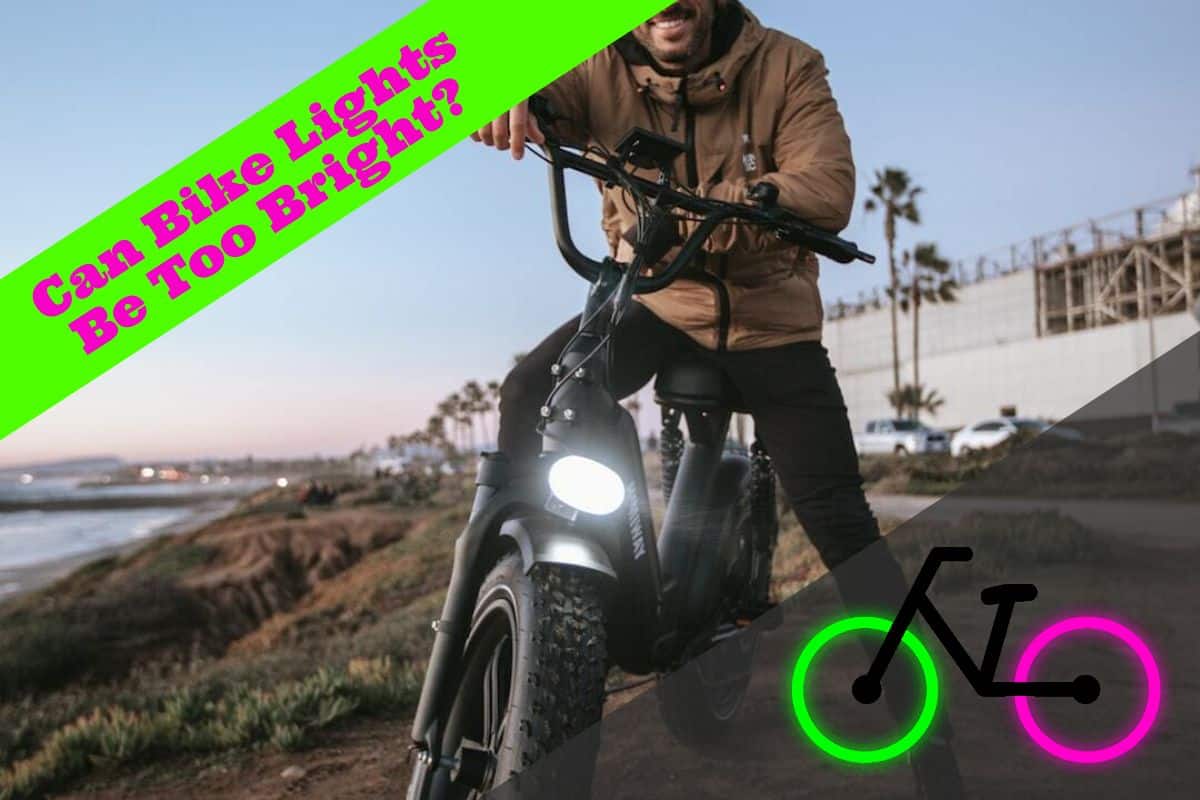As you navigate the streets on your bicycle, one question might pop into your mind: can bike lights be too bright? The simple answer is yes. It’s entirely possible for bike lights to be overly bright, causing more harm than good.

Bike lights serve two essential purposes – helping you see and making you visible to others. However, when these lights are excessively bright, they can blind other road users or cause distractions. Safety should always come first when cycling, and that involves having just the right amount of brightness in your bike lights.
So while it may seem like a brighter light could offer more safety during nighttime rides, there’s a delicate balance that needs to be struck. Too dim and you’re not sufficiently illuminating your path or making yourself visible; too bright and you risk dazzling others which could lead to accidents. Understanding this balance is key for safe cycling.
Understanding Bike Light Brightness
When you’re biking at night, it’s essential to ensure your safety with the right equipment. One crucial item is a bike light. But can a bike light be too bright? Before answering this question, let’s first understand what we mean by brightness.
Brightness in bike lights is typically measured in lumens. This unit measures visible light output, giving you an idea of how much illumination your bike light can provide. It’s important to note that brighter isn’t always better when it comes to bike lights.
Consider these factors:
- Glare: A too-bright light can cause glare for oncoming cyclists or drivers, potentially leading to dangerous situations.
- Battery life: The brighter the light, the quicker it drains battery power.
- Local laws and regulations: Some areas have limits on how bright a bicycle light can legally be.
When choosing a bike light, consider where and when you’ll be cycling most often:
- If you mainly ride in urban areas with well-lit streets: A front light of around 100 to 200 lumens should suffice.
- For rural riding where roads are darker: You might want something more powerful – between 400 and 800 lumens could do the trick.
Here’s a simple table comparing typical lumen ratings for different cycling conditions:
| Riding Conditions | Recommended Lumens |
|---|---|
| Urban Areas | 100 – 200 |
| Rural Roads | 400 – 800 |
Remember, having the brightest bike light doesn’t necessarily make you safer or more visible. Optimal visibility requires careful positioning of your lights and thoughtful consideration about their brightness level relative to your riding conditions.
The Legal Limit for Bike Lights
Ever wondered if there’s a legal limit to how bright your bike lights can be? It’s a great question to consider, especially if you’re often biking in low-light conditions or bustling urban areas.
In the United States, each state has its own regulations regarding bicycle lighting. However, most places require at least one white front light visible from 500 feet and one red rear light that can be seen from at least 600 feet away. Most of these laws don’t specify an exact brightness level in terms of lumens—the unit used to measure light output.
Here are a few examples:
| State | Front Light Requirement | Rear Light Requirement |
|---|---|---|
| California | Visible from 300 feet. Flashing light is acceptable. | Visible from 500 feet. Red reflector when no light present. |
| New York | Must be able to see at least 50 feet ahead. Flashing not permitted. | Red taillight visible up to 300 feet behind. |
| Florida | Visible from 500 feet. | Visible from 600 feet. |
While these laws set minimum levels, they typically don’t establish a maximum brightness level for bike lights. But it doesn’t mean you should opt for the brightest lights possible without considering other factors.
When choosing your bike lights, it’s essential not only to think about visibility but also about not blinding oncoming traffic—be it drivers or fellow cyclists—with excessive glare from overly bright lights. This is more of an ethical responsibility than a legal requirement but equally important.
Another aspect worth considering is that excessively bright bike lights can drain batteries faster, meaning they might not last as long as you’d like them on longer rides.
« How to Stop Bike Lights from Being Stolen: A Comprehensive Guide for Cyclists
Best Bike Headlights: Illuminate Your Night Rides Safely »
So while there may be no specific legal upper limit for bike light brightness, using common sense and consideration for others will ensure that you’re seen on the road without causing unnecessary risk or irritation to others around you.
Potential Dangers of Overly Bright Bike Lights
When you’re cycling at night, visibility is key. It’s important to see and be seen by others on the road. However, there’s a catch. Can bike lights be too bright? Yes, indeed they can.
Overly bright bike lights may not only be unnecessary but potentially hazardous too. They might seem like the perfect solution for your nighttime rides, but it’s crucial to remember that brighter isn’t always better.
One major issue with excessively bright bike lights is their potential to blind other road users. This becomes particularly problematic when your light shines directly into someone else’s eyes, causing temporary vision impairment which could lead to accidents.
- Glare: Glare from overly bright bike lights can significantly affect another person’s ability to see clearly.
- Distraction: Bright flashes or constant high-intensity light can easily distract other riders or drivers.
- Confusion: Sometimes an extremely bright bicycle light may confuse others on the road as they may mistake it for a motor vehicle in the distance.
If you’re thinking that more lumens equates safer riding – think again! The brightness of your light should match your riding conditions. On well-lit urban streets, less intense lighting should suffice while rural roads with no streetlights might require more powerful illumination.
Your goal should be balanced lighting that enhances both yours and others’ safety on the road. Remember: choose wisely because being considerate goes a long way in maintaining harmony and safety among all road users!
Remember these points:
- Avoid shining your light directly into other people’s eyes.
- Adjust the angle of your light downwards slightly.
- Use lower settings in built-up areas or when passing pedestrians or cyclists.
- Don’t use flashing modes at night – they are disorienting for other people.
All this doesn’t mean you have to compromise on safety – far from it! It simply means adopting smart practices which ensure everyone’s well-being on the roads after dark!
How to Determine If Your Bike Light Is Too Bright
Ever wondered, “Is my bike light too bright?” It can be challenging to ascertain. Here’s a quick guide that’ll help you navigate through this.
Firstly, consider the environment where you’re cycling. Urban settings with well-lit streets don’t require excessively bright lights. On the other hand, rural or off-road trails with minimal lighting might need brighter illumination for safety reasons.
Secondly, take note of any feedback from others. If multiple people are complaining about your bike light being blinding or causing discomfort, it’s likely too bright.
Brightness levels in bike lights are measured in lumens. A table below shows recommended lumen ranges based on different types of riding:
| Type of Riding | Recommended Lumens |
|---|---|
| Urban Commuting | 100 – 300 lumens |
| Rural Riding | 400 – 600 lumens |
| Off-road Mountain Biking | Over 600 lumens |
Remember that these figures are guidelines and personal preferences may vary.
Another vital factor is how you position your bike light. Even a reasonably lit light can seem unbearably bright if not pointed correctly. Ideally, your headlight should aim slightly downwards so as not to blind oncoming traffic while still illuminating the path ahead.
Here are some tips to avoid unnecessary dazzle:
- Avoid directing your beam straight into others’ eyes
- Adjust the angle of your light downward
- Use lower brightness settings in well-lit areas
So there’s no definitive answer to “Can bike lights be too bright?” It depends on various factors like where you’re cycling, how you’ve positioned your light and even feedback from others around you!
The Impact of Bright Bike Lights on Other Road Users
There’s a common question among cyclists: can bike lights be too bright? While you might think brighter is better, it’s essential to consider how your bike lights impact other road users.
When you’re cycling at night, your bike lights serve two critical functions. First, they provide illumination of the path ahead for safety. Secondly, they make you visible to other road users such as drivers and pedestrians. However, if your light is excessively bright or poorly positioned, it could potentially dazzle other road users. Dazzling refers to the temporary blindness caused by sudden exposure to bright light.
A survey conducted by Cycle magazine found that nearly 20% of respondents have been dazzled by another cyclist’s front light. This isn’t just an inconvenience; it can create dangerous situations on the roadways.
Here are some stats from the survey:
| Response | Percentage |
|---|---|
| Never | 24% |
| Seldom | 56% |
| Often | 16% |
| Don’t Know/Not Sure | 4% |
Although there aren’t explicit regulations around maximum brightness for bike lights in many regions, there are general guidelines that cyclists should follow:
- Use a front light with a lumens rating suitable for your environment – urban riders don’t need as strong a light as rural riders.
- Position your bike light correctly so it illuminates the path without blinding others.
- Avoid flashing modes in busy urban areas where there are lots of other road users.
Remember – while visibility is paramount when biking at night or during poor weather conditions, being considerate of others’ visual comfort contributes to overall safety on shared roads. So next time before you hit the streets after dusk with super-bright LEDs blazing away at full power, think about how your lighting choices affect everyone else on the road.
Adjusting Bike Light Intensity for Safety
You might be wondering, “Can bike lights be too bright?” You’re not alone in this query. The answer to it lies in a delicate balance between visibility and safety.
On one hand, brighter lights increase your visibility on the road. They alert other motorists of your presence, making night rides safer for you. However, there’s a flip side to this argument. Super bright lights can blind incoming drivers or pedestrians, leading to accidents.
So how do you strike that perfect balance? It’s all about adjusting the intensity of your bike light appropriately.
Let’s start with the basics: what is lumens? Lumens is the unit used to measure light output. Generally speaking, more lumens means a brighter light. For city riding at night, 100-200 lumens typically suffice whereas country roads with no street lighting require 300-400 lumens.
| Type Of Road | Lumens Required |
|---|---|
| City streets with some form of lighting | 100-200 Lumens |
| Country roads without any street lighting | 300-400 Lumens |
Next up is understanding beam pattern and angle. Your bike light should illuminate enough of your path without blinding others. That could mean tilting it downwards or choosing a light with an appropriate beam pattern.
Finally yet importantly, consider flashing modes for maximum visibility but minimum distraction to others:
- Use flashing mode in well-lit areas where you just need to stand out from ambient lighting.
- In darker areas or while riding at high speeds, switch over to steady mode as rapidly blinking lights can disorientate others or yourself.
To sum up:
- Understand luminosity requirements based on your route type.
- Optimize beam pattern and tilt angle.
- Choose between steady and flash modes judiciously.
Adjusting these factors will ensure a safe ride for both yourself and those around you while answering that question – Yes, bike lights certainly can be too bright if not managed properly!
Comparison: Standard Vs. High-Intensity Bike Lights
When you’re choosing between standard and high-intensity bike lights, there are a couple of key factors to consider. Let’s delve into the specifics.
Firstly, consider brightness. Standard bike lights typically range from 100 to 200 lumens, which is sufficient for most city rides or well-lit trails. On the other hand, high-intensity bike lights can crank up brightness all the way to 800 lumens or more – perfect if you’re a night-time trail blazer.
| Standard Bike Lights | High Intensity Bike Lights | |
|---|---|---|
| Brightness (lumens) | 100 – 200 | Up to 800+ |
Next up is battery life. You’ll find that standard bike lights tend to have longer battery longevity due to their lower light output. However, high-intensity models consume more power as they shine brighter, potentially leading to shorter run times.
But what about visibility? Yes, brighter may mean more visible — but it’s not always necessary or even safe! Extremely bright lights can dazzle and impair vision for oncoming traffic or fellow cyclists.
Here’s something else: think about where you’ll be riding mostly.
- If it’s in urban areas with street lighting, standard brightness will do just fine.
- But if your journey takes you on unlit roads and trails after sunset, those high-intensity beams could be lifesavers.
Finally let’s talk about cost because who doesn’t love saving money? Generally speaking,
- Standard bike lights are less expensive than their high-intensity counterparts.
- Opting for higher intensity means shelling out extra bucks but could provide better visibility in darker conditions.
Remember, too much light isn’t always right! Your aim should be finding that sweet spot between being seen clearly without causing discomfort or danger to others. That’s why it’s crucial that your choice reflects your biking habits and environmental conditions rather than opting for sheer luminosity alone.
Tips to Balance Visibility and Politeness in Urban Cycling
Navigating the urban jungle on two wheels can be a challenge, especially when it comes to making yourself seen without blinding others with your bike lights. Here’s how you can strike a balance between visibility and consideration for other road users.
Adjustability is key. Choose bike lights that offer adjustable brightness settings. This way, you can crank it up while cycling along poorly-lit areas but dial it back down when you’re around pedestrians or other cyclists.
Position matters. Consider where you’ve mounted your lights. A well-placed light won’t just improve your visibility, it’ll also minimize the chances of dazzling others. Tip: point your headlight slightly downwards so its beam illuminates the path ahead without shining directly into people’s eyes.
Use flashing modes sparingly. Flashing lights do grab attention quickly but they can also disorientate others if overused or used in close proximity. Save them for situations where maximum visibility is crucial.
Don’t overlook ambient lighting conditions either. You might need less powerful lighting on well-lit city streets compared to rural roads with no streetlights.
Remember: urban cycling isn’t just about being seen – it’s also about seeing clearly yourself! Invest in high-quality front lights that help illuminate obstacles on your path, ensuring safer rides at night or during low-light conditions.
Lastly, always make sure you’re following local laws and regulations concerning bicycle lighting – it’s not only polite but keeps everyone safe too!
Balancing visibility with politeness might seem like a tricky task, but with these tips under your belt, you’ll be able to navigate through the urban landscape confidently and considerately – ensuring both your safety and those around you.
Expert Opinions on Ideal Bike Light Brightness
When it comes to bike lights, you might wonder if there’s such a thing as too bright. Well, according to experts, there can be a sweet spot. It’s not just about having the brightest light possible; it’s also about visibility and safety.
Bike light brightness is generally measured in lumens. A common misconception is that more lumens mean better visibility. However, this isn’t always the case. For city riding or commuting where there are other sources of light, you typically don’t need an extremely bright light. Experts suggest somewhere between 100-300 lumens would suffice for most urban settings.
| Riding Condition | Suggested Lumens |
|---|---|
| Urban commuting | 100 – 300 |
| Rural riding | 400 – 600 |
| Mountain biking | 600+ |
For rural rides where street lights are scarce, a brighter light around 400-600 lumens may be necessary. And for those off-road adventures or mountain biking at night? You’ll likely need something even stronger – say above 600 lumens.
Remember though, it’s not all about brightness alone! Factors like beam pattern and angle also play important roles in how effective your bike lights are.
- Beam Pattern: Some lights have a focused beam while others spread out more evenly.
- Angle: The angle of your light can affect how far ahead you’re able to see and whether you’re blinding oncoming traffic.
So remember to consider these factors when choosing your bike lights! No matter what type of cycling you do or where your ride takes you, ensure your choice keeps you and others safe on the road at all times.
Conclusion: Striking a Balance with Your Bike’s Lighting
It’s not about how bright your bike lights can be, but rather how well they aid in ensuring your safety on the road. You’ve learned that excessively bright bike lights may cause more harm than good, potentially blinding other motorists and obscuring your visibility instead of enhancing it.
Striking a balance is key here. On one hand, you need sufficient brightness to alert others of your presence and illuminate your path. On the other hand, you must ensure that this brightness doesn’t become a hazard for others sharing the road with you.
Remember these points:
- Regulate the intensity: Use bike lights which have multiple settings so you can adjust their brightness according to conditions.
- Angle correctly: Ensure that your light is angled down towards the road and not straight ahead into oncoming traffic’s line of sight.
- Follow regulations: Be aware of local laws regarding bicycle lighting as they differ by region and adhere strictly to them.
You now have all the information needed to make an informed decision about choosing and using bike lights wisely. With proper lighting, not only will your night rides be safer but also more enjoyable!




